Toward Realization of 2.4 GHz Balunless Narrowband Receiver Front-End for Short Range Wireless Applications
Abstract
:1. Introduction
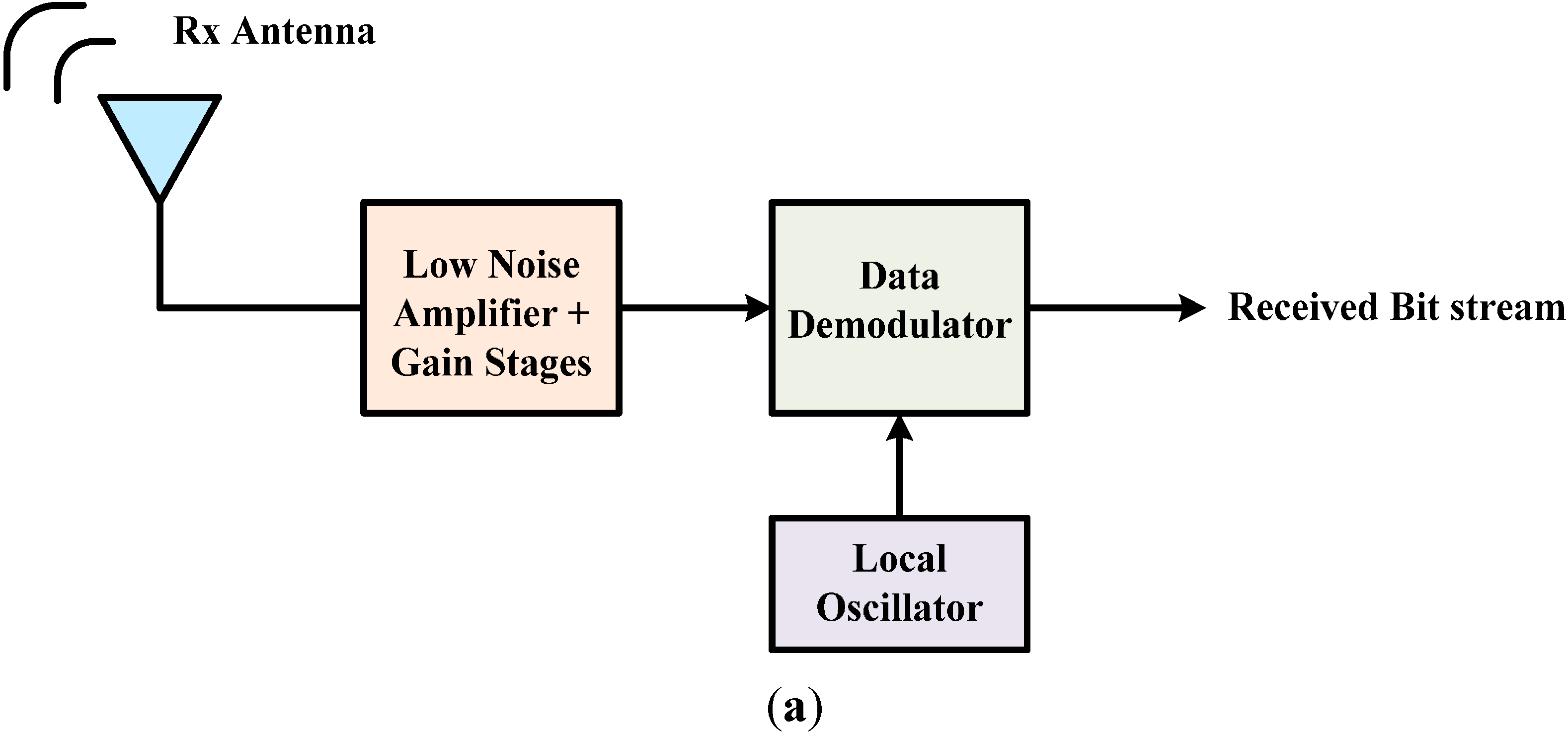

2. Narrowband Receiver Front-End Architecture
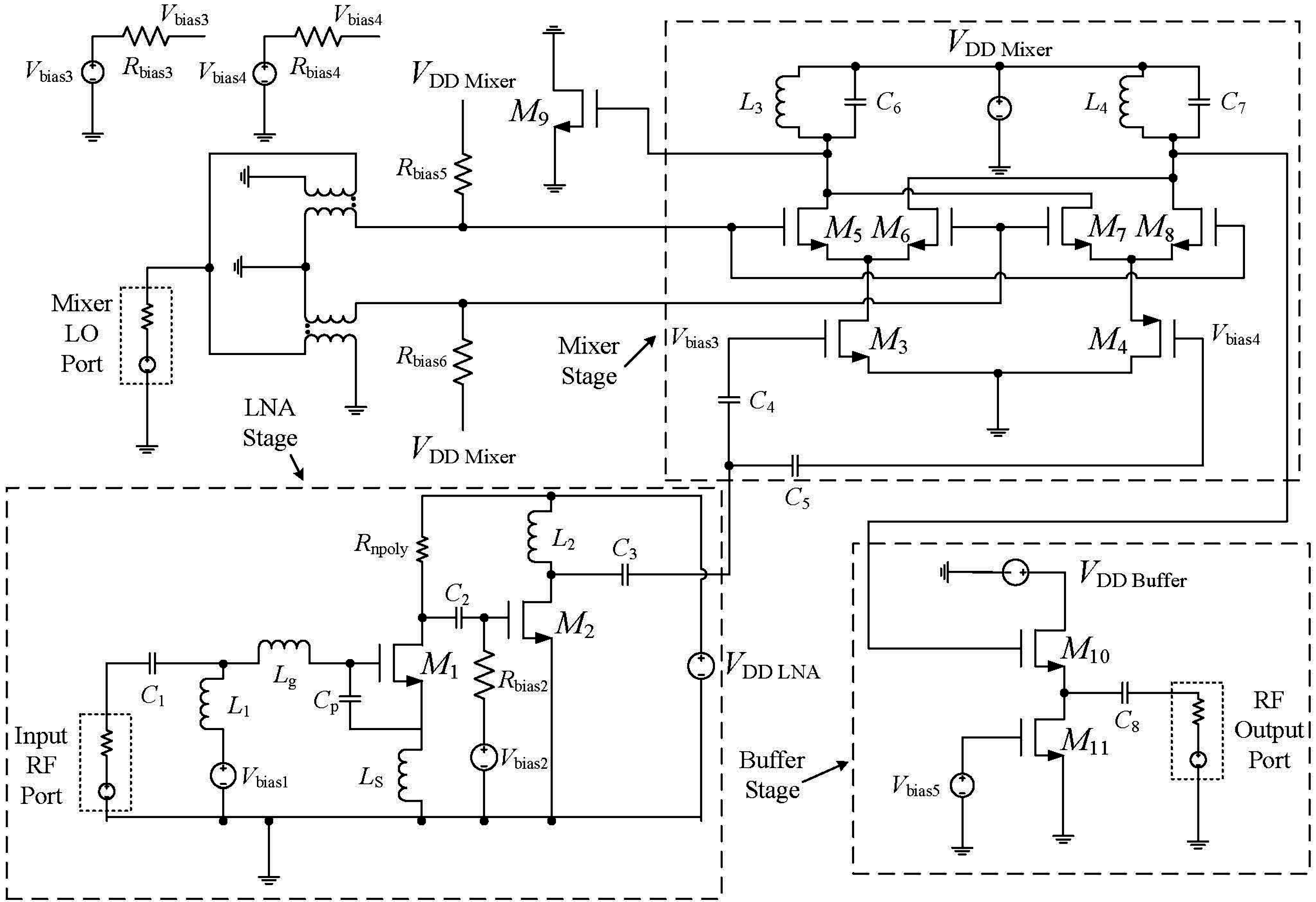
2.1. Narrowband LNA
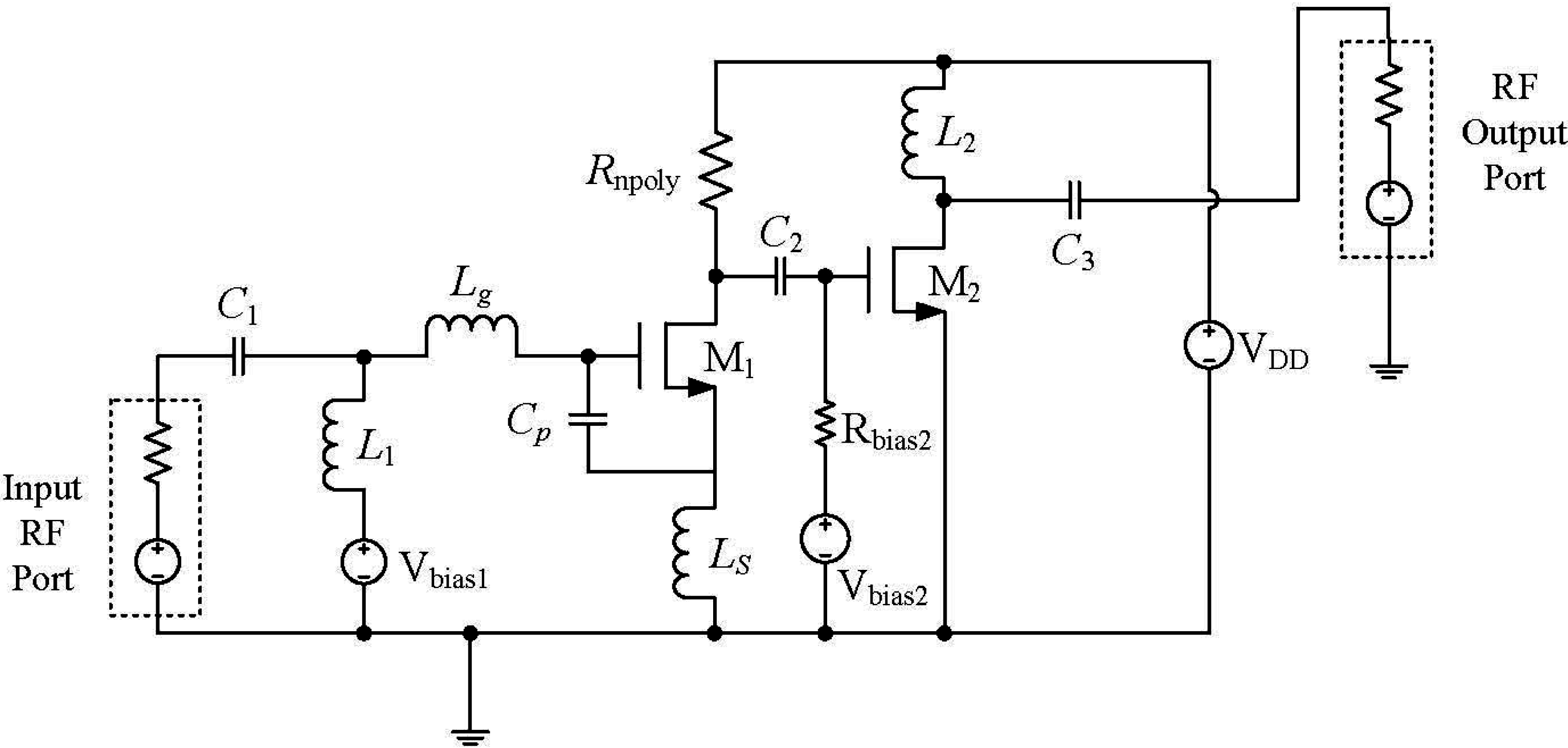
2.2. Downconversion Double Balanced Mixer
- When the RF input signal is increasing, the current in the NMOS branch is increasing while the current in the PMOS branch is decreasing,
- When the RF input signal is decreasing, the current in the NMOS branch is decreasing while the current in the PMOS branch is increasing.
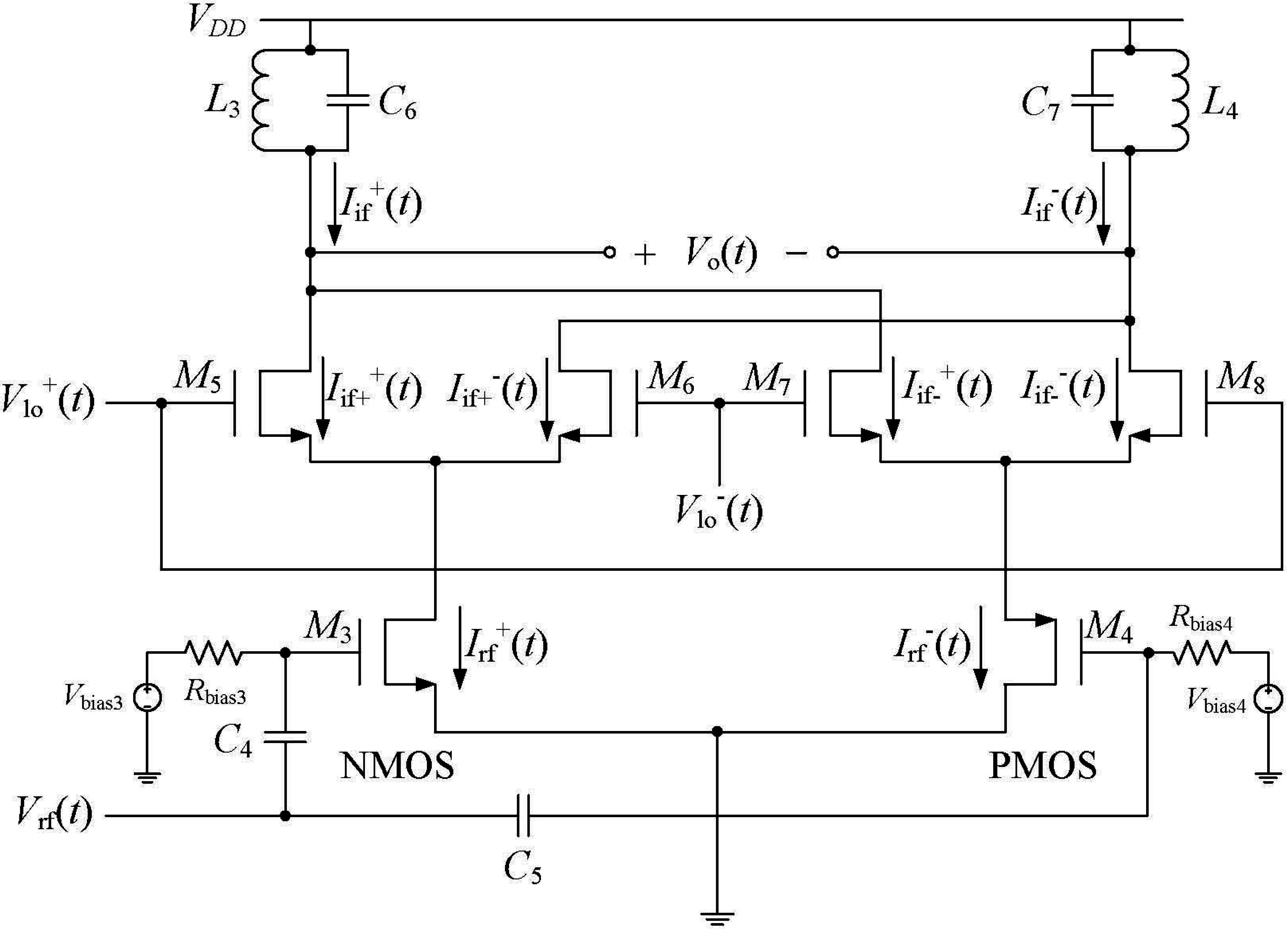
3. Simulation and Measurement Results
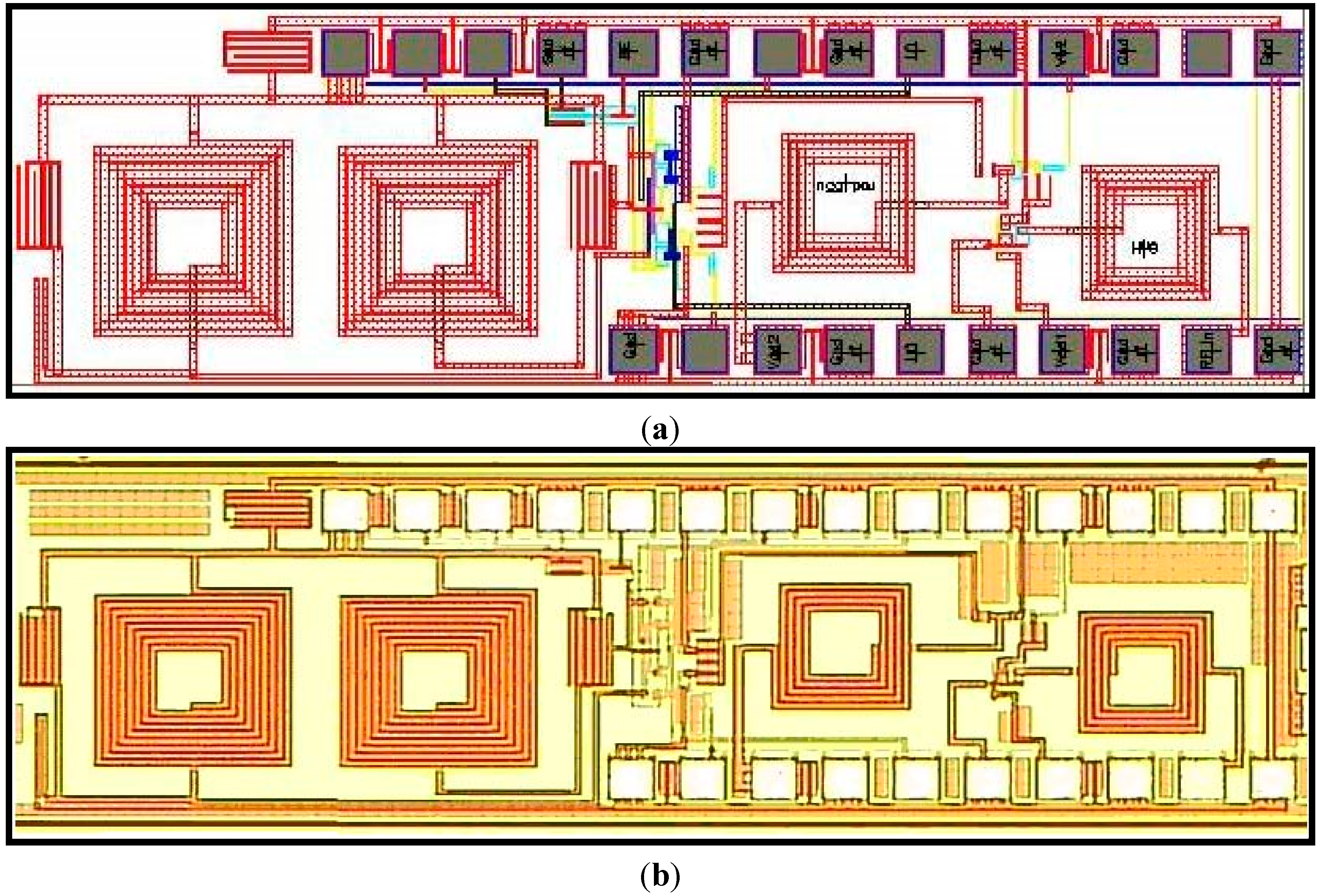

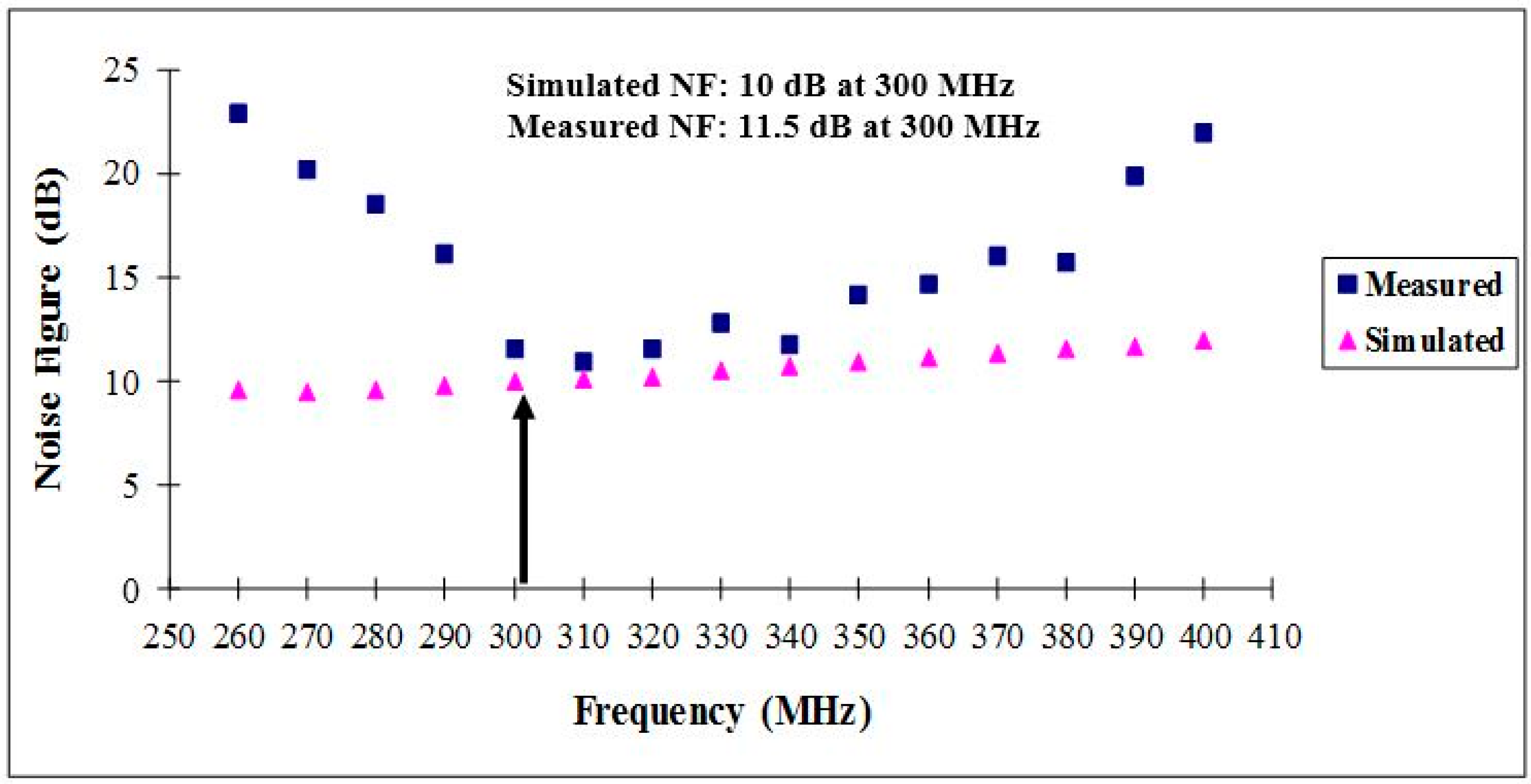
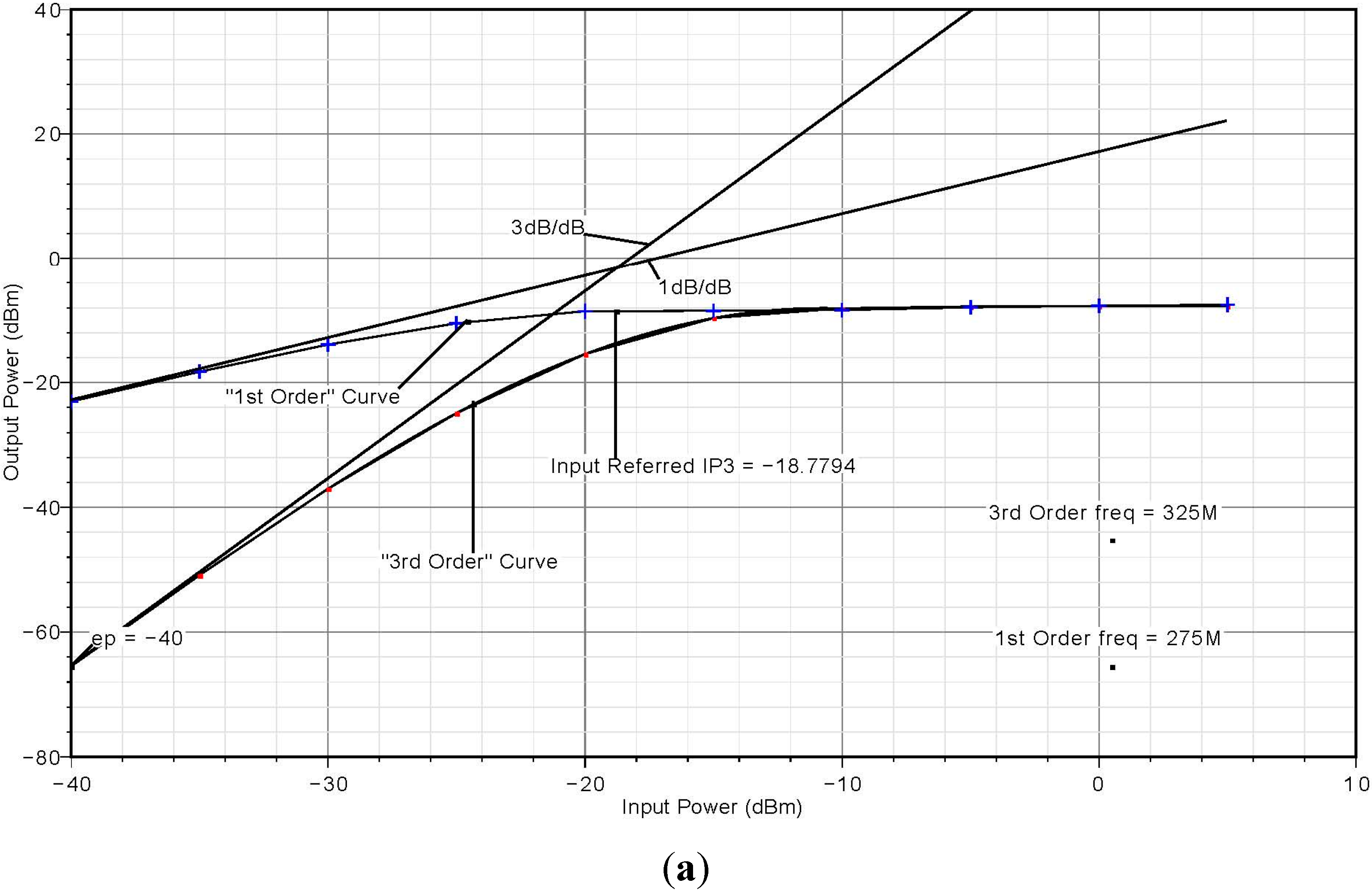
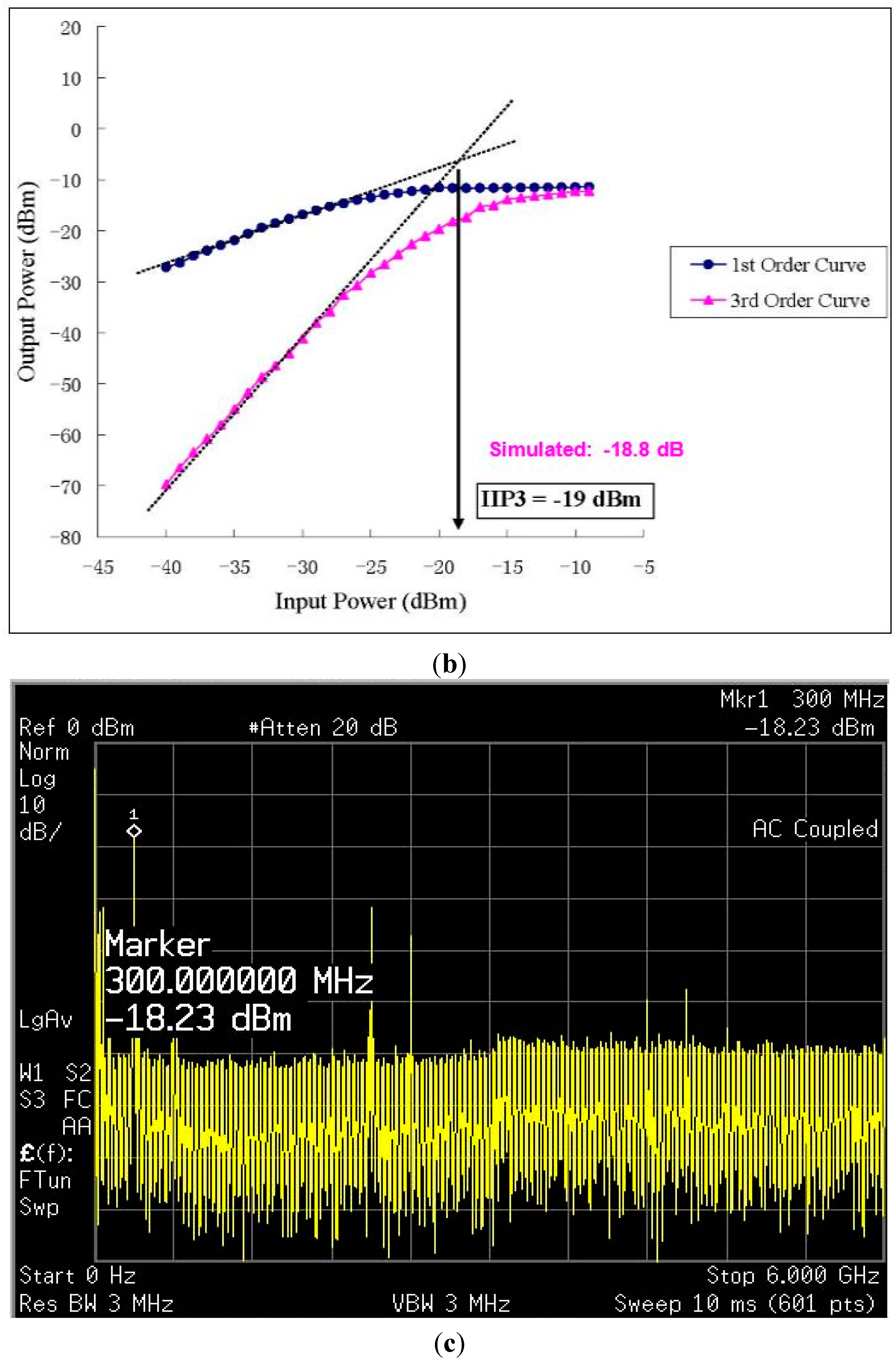
4. Performance Evaluation
| Simulated | Measured | |
|---|---|---|
| CMOS Technology (µm) | 0.18 | 0.18 |
| RF frequency (GHz) | 2.40 | 2.40 |
| Gain (Differential) | 18.2 | 16.3 |
| Gain (Single-ended) | 15.3 | 13.3 |
| NF (dB) | 10.0 | 11.5 |
| IIP3 (dBm) | −18.8 | −19.0 |
| Power dissipation (without buffer) (mW) | 5.573 | 6.74 |
| Power dissipation (with buffer) (mW) | 12.035 | 12.85 |
| CMOS Tech. (µm) | Frequency (GHz) | Gain (dB) | NF (dB) | IIP3 (dBm) | Pdiss (mW) | Chip Area (mm2) | FoM | |
|---|---|---|---|---|---|---|---|---|
| Simulated | 0.18 | 2.4 | 18.2 | 10 | −18.8 | 5.57 | 2.08 | 170 |
| Measured | 0.18 | 2.4 | 16.3 | 11.5 | −19 | 6.74 | 2.08 | 165 |
| [24] | 0.09 | 2.4 | 30 | 18 | −22 | 8.5 | 3.4 | 168 |
| [25] | 0.13 | 2.4 | 12.5 | 28 | −21 | 3.4 | 3.3 | 146 |
| [26] | 0.18 | 2.44 | 8 | 8.9 | −13.5 | 2.754 | †† | 169 |
| [27] | 0.25 | 2.4 | 14.5 | 4.8 | −18 | 11.3 | 1.82 | 169 |
| [28] | 0.18 | 2.4 | 21.4 | 13.9 | −18 | 6.5 | NA | 169 |
| [29] | 0.18 | 2.4 | 20.4 | 19 | NA | 0.5 | 0.765 ** | - |
| [30] | 0.13 | 2.1 | 15 * | 15.7 * | −3 * | 12 | 1.1 | 172 |
| [31] | 0.13 | 2.4 | 12 * | 30 * | 0 * | 25.2 | 0.612 ** | 156 |
| [32] | 0.18 | 2.4 | 18 | 8 | −15 | 8.7 | 0.263 ** | 173 |
- requires a single-ended RF input without the need of using on-chip transformer/balun;
- has a simple circuit architecture that eases the process of fabrication;
- reduces power consumption by avoiding on-chip lossy reactive elements;
- provides competitive overall performance compared to other designs.
5. Conclusions
Acknowledgments
Author Contributions
Conflicts of Interest
References
- Almazyad, A.S.; Seddiq, Y.M.; Alotaibi, A.M.; Al-Nasheri, A.Y.; BenSaleh, M.S.; Obeid, A.M.; Qasim, S.M. A Proposed Scalable Design and Simulation of Wireless Sensor Network-Based Long-Distance Water Pipeline Leakage Monitoring System. Sensors 2014, 14, 3557–3577. [Google Scholar] [CrossRef]
- BenSaleh, M.S.; Qasim, S.M.; Obeid, A.M.; Garcia-Ortiz, A. A Review on Wireless Sensor Network for Water Pipeline Monitoring Applications. In Proceedings of the International Conference on Collaboration Technologies and Systems (CTS), San Diego, CA, USA, 20–24 May 2013; pp. 128–131.
- Seddiq, Y.M.; Alotaibi, A.M.; Al-Nasheri, A.Y.; Almazyad, A.S.; BenSaleh, M.S.; Qasim, S.M. Evaluation of Energy-Efficient Cooperative Scheme for Wireless Sensor Nodes used in Long Distance Water Pipeline Monitoring Systems. In Proceedings of the Fifth International Conference on Computational Intelligence, Communication Systems and Networks (CICSyN), Madrid, Spain, 5–7 June 2013; pp. 107–111.
- Liu, X.; Zheng, Y.; Zhao, B.; Wang, Y.; Phyu, M.W. An ultra low power baseband transceiver IC for wireless body area network in 0.18-µm CMOS technology. IEEE Trans. Very Large Scale Integr. (VLSI) Syst. 2011, 19, 1418–1428. [Google Scholar] [CrossRef]
- Wong, A.C.W.; Dawkins, M.; Devita, G.; Kasparidis, N.; Katsiamis, A.; King, O.; Lauria, F.; Schiff, J.; Berdett, A.J. A 1V 5mA multimode IEEE 802.15.6/bluetooth low-energy WBAN transceiver for biotelemetry applications. IEEE J. Solid-State Circuits 2013, 48, 186–198. [Google Scholar] [CrossRef]
- El-Desouki, M.M.; Qasim, S.M.; BenSaleh, M.; Deen, M.J. Single-Chip Fully Integrated Direct-Modulation CMOS RF Transmitters for Short-Range Wireless Applications. Sensors 2013, 13, 9878–9895. [Google Scholar] [CrossRef]
- El-Desouki, M.M.; Deen, M.J.; Haddara, Y.M.; Marinov, O. A fully integrated CMOS power amplifier using superharmonic injection-locking for short-range applications. IEEE Sensors J. 2011, 11, 2149–2158. [Google Scholar] [CrossRef]
- Asgaran, S.; Deen, M.J.; Chen, C.H. A 4 mW monolithic CMOS LNA at 5.7 GHz with the Gate Resistance Used for Input Matching. IEEE Microw. Wirel. Compon. Lett. 2006, 16, 188–190. [Google Scholar] [CrossRef]
- Deen, M.J.; Murji, R.; Fakhr, A.; Jafferali, N.; Ngan, W.L. Low power CMOS integrated circuits for radio frequency applications. IEE Proc. Circuit Device Syst. 2005, 152, 509–522. [Google Scholar] [CrossRef]
- Deen, M.J.; Fjeldy, T.A. CMOS RF Modeling, Characterization and Applications; World Scientific Publishing Co.: Singapore, 2002. [Google Scholar]
- Deen, M.J.; El-Desouki, M.M.; Jafari, H.M.; Asgaran, S. Low-power integrated CMOS RF transceiver circuits for short-range applications. In Proceedings of the 50th Midwest Symposium on Circuits and Systems (MWSCAS), Montreal, QC, Canada, 5–8 August 2007; pp. 1544–1549.
- Kluge, W.; Poegel, F.; Roller, H.; Lange, M.; Ferchland, T.; Dathe, L.; Eggert, D. A fully integrated 2.4-GHz IEEE 802.15.4-compliant transceiver for zigbee applications. IEEE J. Solid-State Circuits 2006, 41, 2767–2775. [Google Scholar] [CrossRef]
- Murji, R.; Deen, M.J. Design issues of a low power wideband frequency doubler implementation in 0.18 μm CMOS. Analog Integr. Circuits Signal Process. 2007, 53, 53–62. [Google Scholar] [CrossRef]
- Chan, A.N.L.; Ng, K.W.H.; Wong, J.M.C.; Luong, H.C. A 1-V 2.4-GHz CMOS RF receiver front-end for Bluetooth application. In Proceedings of the IEEE International Symposium on Circuits and Systems (ISCAS), Sydney, Australia, 6–9 May 2001; pp. 454–457.
- Behbahani, F.; Leete, J.C.; Kishigami, Y.; Roithmeier, A.; Hoshino, K.; Abidi, A.A. A 2.4-GHz low-IF receiver for wideband WLAN in 0.6-µm CMOS-architecture and front-end. IEEE J. Solid-State Circuits 2000, 35, 1908–1916. [Google Scholar] [CrossRef]
- Wang, D.; Krishnamurthi, K.; Gilbson, S.; Brunt, J. A 2.5 GHz low noise high linearity LNA/mixer IC in SiGe BiCMOS technology. In Proceedings of the Digest of Papers of Radio Frequency Integrated Circuits (RFIC) Symposium, Phoenix, AZ, USA, 20–22 May 2001; pp. 249–252.
- Razavi, B. A 2.4-GHz CMOS receiver for IEEE 802.11 wireless LAN’s. IEEE J. Solid-State Circuits 1999, 34, 1382–1385. [Google Scholar] [CrossRef]
- Nam, I.; Kim, B.; Lee, K. CMOS RF amplifier and mixer circuits utilizing complementary characteristics of parallel combined NMOS and PMOS devices. IEEE Trans. Microw. Theory Technol. 2005, 53, 1662–1671. [Google Scholar] [CrossRef]
- Asgaran, S.; Deen, M.J.; Chen, C.H. Design of the input matching network of RF CMOS LNAs for low-power operation. IEEE Trans. Circuit Syst. I Regul. Pap. 2007, 54, 544–554. [Google Scholar] [CrossRef]
- Bevilacqua, A.; Niknejad, A.M. An Ultrawideband CMOS Low-Noise Amplifier for 3.1–10.6-GHz Wireless Receivers. IEEE J. Solid -State Circuits 2004, 39, 2259–2268. [Google Scholar] [CrossRef]
- Zhou, G. Narrow-Band Receiver and Ultra-Wideband Low Noise Amplifier. Master’s Thesis, Department of Electrical and Computer Engineering, McMaster University, Hamilton, ON, Canada, 2009. [Google Scholar]
- Chen, C.H.; Deen, M.J. High frequency noise of MOSFETs I Modeling. Solid-State Electron. 1998, 42, 2069–2081. [Google Scholar] [CrossRef]
- El-Desouki, M.M.; Abdelsayed, S.M.; Deen, M.J.; Nikolova, N.K.; Haddara, Y.M. The Impact of on-chip interconnections on CMOS RF integrated circuits. IEEE Trans. Electron. Devices 2009, 56, 1882–1890. [Google Scholar] [CrossRef]
- Stanic, N.; Balankutty, A.; Kinget, P.; Tsividis, Y. A 2.4 GHz ISM-band sliding IF receiver with a 0.5 V supply. IEEE J. Solid-State Circuits 2008, 43, 1138–1145. [Google Scholar] [CrossRef]
- Jarvinen, J.A.M.; Kaukovuori, J.; Ryynanen, J.; Jussila, J.; Kivekas, K.; Honkanen, M.; Halonen, K.A.I. 2.4 GHz Receiver for Sensor Applications. IEEE J. Solid-State Circuits 2005, 40, 1426–1433. [Google Scholar] [CrossRef]
- Srinivasan, S.K.; Rusu, A.; Ismail, M. Ultra-low power 2.4 GHz CMOS receiver front-end for sensor nodes. In Proceedings of the 18th European Conference on Circuit Theory and Design, Seville, Spain, 26–30 August 2007; pp. 595–598.
- Yoo, S.S.; Yoo, H.J. A low power current-reused CMOS RF front-end with stacked LNA and mixer. In Proceedings of the Topical Meeting on Silicon Monolithic Integrated Circuits in RF Systems, Long Beach, CA, USA, 10–12 January 2007; pp. 103–106.
- Beffa, F.; Vogt, R.; Bachtold, W.; Zellweger, E.; Lott, U. A 6.5-mW receiver front-end for Bluetooth in 0.18 µm CMOS. In Proceedings of the IEEE Radio Frequency Integrated Circuits (RFIC) Symposium, Seattle, WA, USA, 3–4 June 2002; pp. 391–394.
- Song, T.; Oh, H.S.; Yoon, E.; Hong, S. A low-power 2.4-GHz current-reused receiver front-end and frequency source for wireless sensor network. IEEE J. Solid -State Circuits 2007, 42, 1012–1022. [Google Scholar] [CrossRef]
- Feng, Y.; Takemura, G.; Kawaguchi, S.; Kinget, P. Design of a high performance 2 GHz direct-conversion front-end with a single-ended RF input in 0.13-µm CMOS. IEEE J. Solid-State Circuits 2009, 44, 1380–1390. [Google Scholar] [CrossRef]
- Miao, P.; Min, L.; Yin, S.; Dai, F.F. A transformer-loaded receiver front end for 2.4 GHz WLAN in 0.13 µm CMOS. J. Semicond. 2011, 32, 125002-1–125002-6. [Google Scholar] [CrossRef]
- Hung, W.H.; Lin, K.T.; Lu, S.S. A 1.2 V low power receiver for short range applications. In Proceedings of the Progress in Electromagnetics Research Symposium, Xi’an, China, 22–26 March 2010; pp. 899–902.
© 2015 by the authors; licensee MDPI, Basel, Switzerland. This article is an open access article distributed under the terms and conditions of the Creative Commons Attribution license (http://creativecommons.org/licenses/by/4.0/).
Share and Cite
El-Desouki, M.M.; Qasim, S.M.; BenSaleh, M.S.; Deen, M.J. Toward Realization of 2.4 GHz Balunless Narrowband Receiver Front-End for Short Range Wireless Applications. Sensors 2015, 15, 10791-10805. https://doi.org/10.3390/s150510791
El-Desouki MM, Qasim SM, BenSaleh MS, Deen MJ. Toward Realization of 2.4 GHz Balunless Narrowband Receiver Front-End for Short Range Wireless Applications. Sensors. 2015; 15(5):10791-10805. https://doi.org/10.3390/s150510791
Chicago/Turabian StyleEl-Desouki, Munir M., Syed Manzoor Qasim, Mohammed S. BenSaleh, and M. Jamal Deen. 2015. "Toward Realization of 2.4 GHz Balunless Narrowband Receiver Front-End for Short Range Wireless Applications" Sensors 15, no. 5: 10791-10805. https://doi.org/10.3390/s150510791
APA StyleEl-Desouki, M. M., Qasim, S. M., BenSaleh, M. S., & Deen, M. J. (2015). Toward Realization of 2.4 GHz Balunless Narrowband Receiver Front-End for Short Range Wireless Applications. Sensors, 15(5), 10791-10805. https://doi.org/10.3390/s150510791








